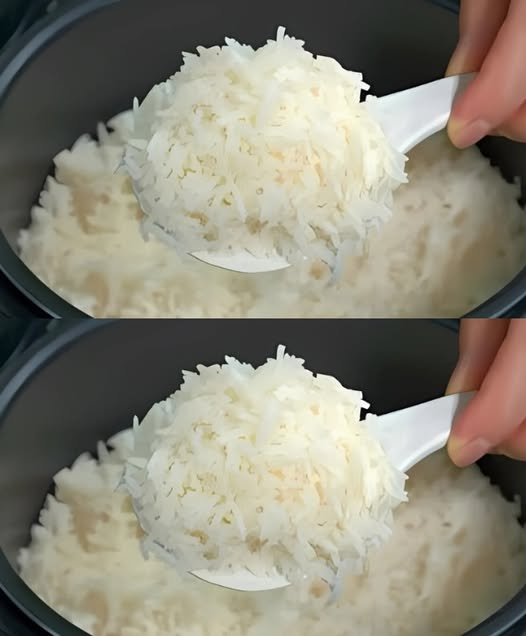ADVERTISEMENT
### The Secret Revealed: Why Pouring Boiling Water Over Rice Works
You might be wondering: “Why does pouring boiling water over rice work so well? Why not just boil the rice normally in water?” It turns out that this technique is not only efficient but also brings out the best texture and flavor in the rice. Here’s a breakdown of why pouring boiling water over rice works:
#### **1. Rice Absorbs Water More Evenly**
The key to perfectly cooked rice lies in how the grains absorb water. When you pour boiling water over rice, the high temperature helps the rice absorb the water more evenly and quickly. Traditional rice cooking methods often rely on simmering rice over a long period, which can lead to uneven absorption of water, resulting in some grains becoming overcooked and others undercooked. By using boiling water, you reduce the risk of this issue, ensuring that each grain cooks uniformly.
#### **2. Prevents Overcooking or Under-Cooking**
One of the most common problems when cooking rice is achieving the right level of doneness. Too little water or too much heat can result in dry, undercooked rice, while too much water or excessive simmering can lead to mushy, overcooked rice. Pouring boiling water over the rice provides precise control over the cooking process. The rice is instantly hydrated and cooked without the need for prolonged simmering, which helps maintain the rice’s perfect texture.
#### **3. Maintains the Rice’s Nutritive Quality**
When cooking rice with boiling water, the grains are subjected to a much gentler cooking process than with traditional methods, especially when using a quick blanching technique. This helps maintain the rice’s nutritional value, as the rice retains more of its vitamins and minerals. In contrast, prolonged boiling can cause nutrients to leach into the water and be lost, especially with delicate varieties of rice like white basmati or jasmine.
#### **4. Better Texture and Fluffiness**
Rice cooked by this method tends to have a lighter, fluffier texture. The grains don’t stick together as much, resulting in a rice that is well-separated, soft but not mushy, and incredibly fragrant. The result is rice that is tender without being soggy—perfect for serving as a side dish or base for other recipes.
#### **5. Perfect for Every Type of Rice**
One of the best things about this method is its versatility. It works across a variety of rice types, whether you’re cooking long-grain varieties like basmati or jasmine, medium-grain varieties like arborio, or short-grain types like sushi rice. Each type of rice benefits from the high heat and even water absorption created by the boiling water method, producing perfect rice every time, regardless of the variety.
### The Method: How to Cook Rice by Pouring Boiling Water Over It
Now that you know why this method works so well, let’s dive into the step-by-step process of cooking rice with boiling water. It’s incredibly simple, but there are a few key steps to follow to get the best results. This method works for white rice, jasmine rice, basmati rice, and other long-grain varieties.
#### **Ingredients:**
– 1 cup of rice (adjust quantity based on your needs)
– 2 cups of water (for cooking)
– Salt (optional, but recommended for flavor)
– A kettle or saucepan to bring the water to a boil
#### **Instructions:**
1. **Rinse the Rice**: Begin by rinsing the rice under cold water. This helps remove excess starch, which can cause the rice to become sticky and clumpy. Rinse until the water runs clear. This step is crucial for ensuring that the rice cooks to perfection.
2. **Bring Water to a Boil**: In a separate kettle or saucepan, bring the water to a boil. The ratio of water to rice is typically 2:1 (2 cups of water for every 1 cup of rice), but this can vary depending on the type of rice you’re using. For example, brown rice will require more water than white rice, so be sure to adjust accordingly.
3. **Place the Rice in a Heatproof Dish**: While the water is coming to a boil, place your rinsed rice in a heatproof dish, such as a large bowl or a deep baking dish. Make sure the dish is large enough to accommodate the rice and the boiling water without spilling over.
4. **Pour the Boiling Water Over the Rice**: Once the water reaches a rolling boil, carefully pour it over the rice. Make sure that the rice is evenly submerged in the boiling water. This is the key moment where the magic happens, as the boiling water will instantly start to cook the rice from the outside in, ensuring a quick and even cooking process.
5. **Cover and Let Sit**: Immediately cover the dish with a tight-fitting lid or a clean towel. This will trap the heat and steam inside, allowing the rice to continue cooking in its own moisture. Let the rice sit for 10-15 minutes, depending on the type of rice you’re using.
6. **Fluff the Rice**: After the rice has had time to steam, uncover the dish and use a fork to gently fluff the rice. This will separate the grains, allowing the steam to escape and ensuring a light, fluffy texture. If the rice is still slightly moist, you can let it sit uncovered for another 5 minutes to allow any remaining moisture to evaporate.
7. **Serve and Enjoy**: Your rice is now perfectly cooked and ready to serve. You can enjoy it as a side dish, mix it into a salad, or use it as a base for stir-fries, curries, or stews. The possibilities are endless!
For Complete Cooking STEPS Please Head On Over To Next Page Or Open button (>) and don’t forget to SHARE with your Facebook friends
